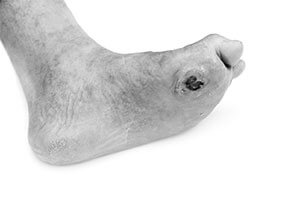 A wound is a break in the skin or tissues that may be caused by an accident, injury, surgery, disease or several other factors, and often involves bleeding, redness, swelling, pain, tenderness and other symptoms. They may occur nearly anywhere on the body. While many wounds can be treated at home by simply cleaning and bandaging the wound, more severe wounds may require professional care.
A wound is a break in the skin or tissues that may be caused by an accident, injury, surgery, disease or several other factors, and often involves bleeding, redness, swelling, pain, tenderness and other symptoms. They may occur nearly anywhere on the body. While many wounds can be treated at home by simply cleaning and bandaging the wound, more severe wounds may require professional care.
Many patients with skin ulcers, burns and other types of wounds face difficulty with the healing process for these troubling wounds, especially if the patient is diabetic. There are several different treatment options available for wounds resistant to conventional therapies. Some of these may include creams, ointments, synthetic skin grafts and other therapies that promote natural healing within the skin to avoid wound complications.
We are proud to offer patients many advanced solutions to their wound healing problems. It is important for wounds to remain clean and free of debris and bacteria in order to properly heal and prevent infection, so proper dressings that are changed on a regular basis are essential. We provide a clean, moist environment that is conducive to healing for most wounds and helps lead toward a quick and efficient recovery, while keeping cosmetic concerns in mind as well.
Your doctor will determine which type of wound care is best for you after an initial evaluation of your wound size, location and severity.
Diabetic Wound Management
People with diabetes are at high risk for developing problems with their feet. Ulcers and other wounds commonly form on the bottom of the foot and can easily become infected or lead to other serious complications. Ulcers may develop as a result of poor circulation, lack of feeling in the feet, irritation or trauma.
Once a wound has been detected, it should be treated immediately in order to prevent complications from developing. Diabetic wound treatment focuses on relieving pressure from the area and removing dead skin cells and tissue through a process called debridement. The wound is then medicated and dressed to prevent infection and promote healing. For more severe wounds, patients may be required to wear special footwear or a brace to relieve pressure and irritation to the wound.
Skin Grafts
Large, severe wounds that cannot be sewn back together for proper healing may require the use of a skin graft, which is a piece of skin taken from another part of the body to be placed over the site of the wound. The graft is excised through a minimally invasive procedure (often from the leg or arm) and then applied to the wound and secured in place with stitches. The wound is covered with a dressing during the healing process.
A graft is often effective in facilitating more efficient healing, as well as providing a more aesthetically-pleasing result. Although a scar will likely be left, it will be much less prominent than if no graft had been applied to the wound.
Debridement
Debridement removes dead tissue from ulcers, burns and other wounds to promote the healing process and reduce the risk of infection. When dead tissue on a wound is exposed to air, it forms a hard crust called an eschar that can hinder healing and lead to bacteria, infection and abscesses. While debridement seems beneficial to the healing process, not all wounds need this procedure.
Debridement can be performed through surgical, mechanical, chemical or autolytic methods, depending on the health and severity of the wound. Surgical debridement is the quickest and most efficient type of procedure, which involves the use of a scalpel, scissors or other instrument to cut dead tissue from a wound.
To learn more about our wound care services, please call us today to schedule an appointment.
